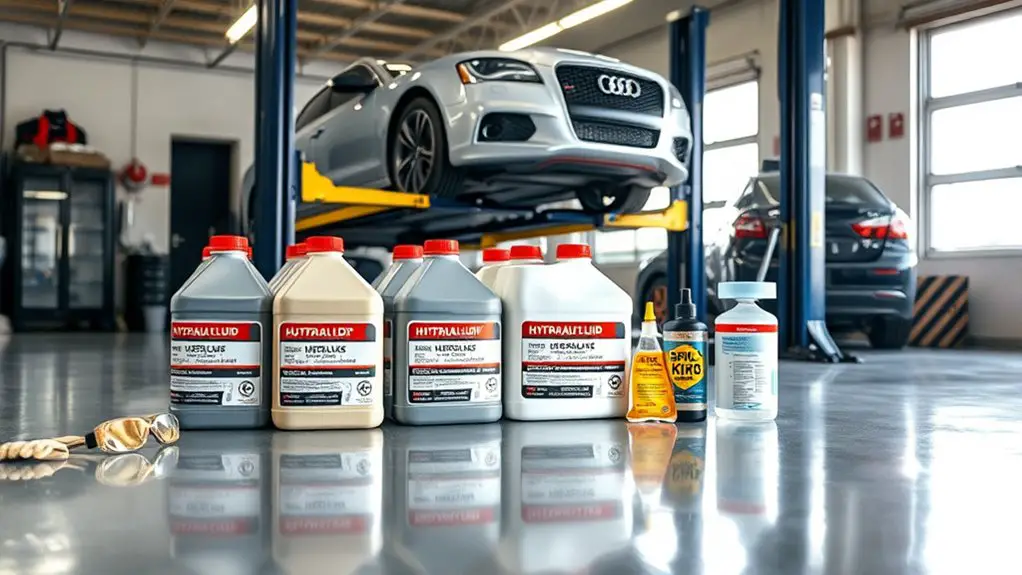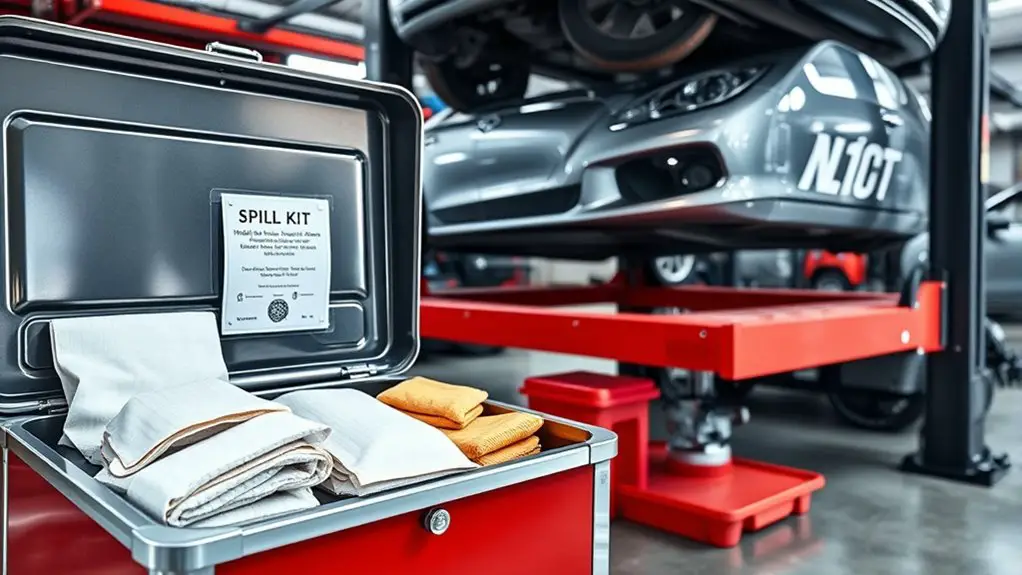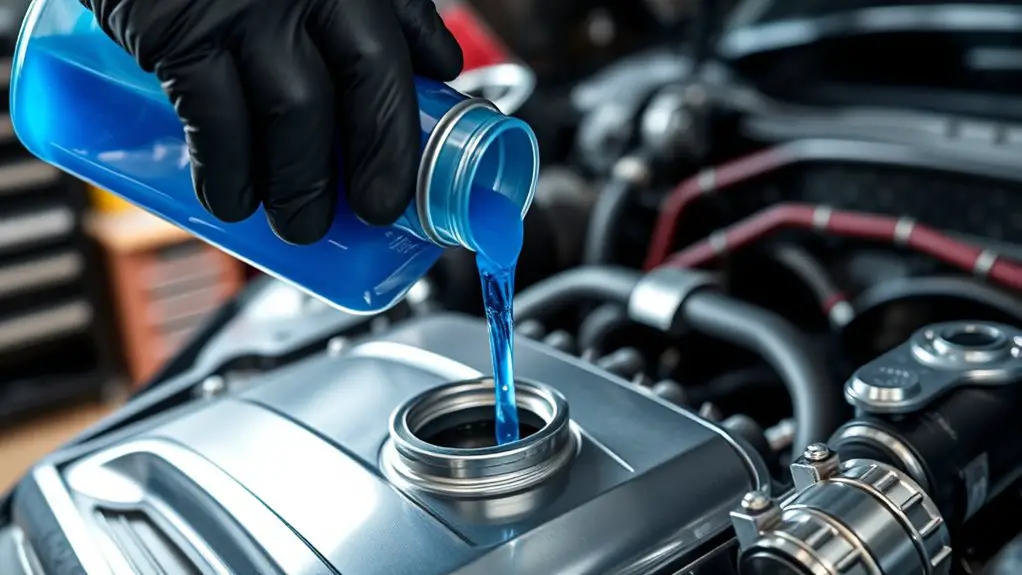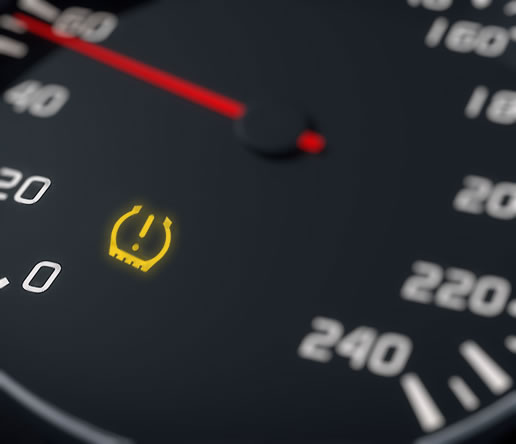Environmental and Safety Tips for Handling Hydraulic Fluid
You should store hydraulic fluid in resistant containers, label everything with contents and dates, and keep shelves off the floor in a clean, ventilated area. Inspect seals regularly and replace worn parts. Prepare for spills with absorbents, booms, and a quick shutdown plan, then document every action. Wear proper PPE—gloves, goggles, and protective clothing—and train staff in labeling and handling procedures. Stay vigilant on leak detection and maintenance; more practical steps await, ready to reduce risk at every turn.
Safe Storage Practices for Hydraulic Fluids

Safe storage starts with choosing the right containers and keeping them in good condition. You’ll want containers that resist hydraulic fluid swell, leaks, and contamination, and lids that seal securely. Inspect seals, gaskets, and closures regularly, replacing any worn parts before a leak begins. Label every container clearly with contents, date, and hazard notes so you stay aligned with safety goals. Store fluids off the floor on sturdy shelving to prevent moisture wicking and accidental spills. Keep storage areas clean, dry, and ventilated, with secondary containment that can hold a full container. Perform safe container selection by matching container materials to the specific fluid’s chemistry, and document compatibility decisions. Practice fluid compatibility testing when introducing new lots or blends, and segregate incompatible products. Implement a routine check for temperature spikes and exposure to direct sunlight, which can degrade quality. Maintain an accessible spill kit nearby and update your records after any change.
Spill Prevention and Response Strategies

Spill prevention starts with a clear plan: identify likely spill scenarios, establish quick-response procedures, and keep the right tools ready. You map routes where fluid pools, note high-traffic machines, and designate a spill kit location that’s accessible in minutes. Regular drills train your crew to act calmly, minimize spread, and protect nearby drains. Maintain containment options: absorbents, booms, and compatible sorbents, plus a labeled waste bag for used materials. Establish containment boundaries, test floor integrity, and seal minor leaks before they become bigger problems. In the moment of a spill, you shut down the source, alert teammates, and deploy absorbents along the margin of the spill to confine it. Cleanup proceeds with a stepwise approach: monitor for rebound, collect contaminated materials, and document quantities and affected areas. Your emergency response planning includes post-event review, revised procedures, and reinforced training to reduce recurrence and preserve a safe, free-working environment.
Personal Protective Equipment for Handling Hydraulic Fluid

When handling hydraulic fluid, your PPE list isn’t optional—it’s part of the job’s smallest, most important safeguards. You’ll want safety goggles to protect eyes from splashes and fine mist, plus chemical gloves that resist oils and solvents. Inspect PPE before use; look for cracks, tears, and degraded coatings. Choose gloves with the right breakthrough time for the specific fluid you handle, and consider cut resistance if you’ll manipulate sharp components. Body protection matters too: long sleeves, a resistant lab coat, and closed-toe shoes reduce skin exposure and exposure pathways. If you anticipate splashes or fumes, add a face shield or respirator approved for organic solvents, and verify proper seal checks. Store PPE in predictable places, clean and dry, so you reach for it without hesitation. Remove contaminated gear at the exit, wash hands, and replace items as needed. Your disciplined PPE routine minimizes exposure and supports safe, confident work.
Proper Labeling and Documentation
Labeling standards guarantee you can identify hydraulic fluid quickly, so you should follow uniform color codes, clear product names, and hazard statements. Documentation practices mean you keep up-to-date logs for changes, handling steps, and container histories, with easy access for staff. Compliance records should be current and verifiable, reflecting audits, training, and any incidents related to labeling or documentation.
Labeling Standards
Labeling standards are your first line of defense for safe hydraulic fluid handling. When you label, you set clear expectations, reduce mix-ups, and support quick hazard recognition. Focus on concise, durable labels, readable fonts, and prominent color-coding that travels with each container. Verify every container, drum, and secondary reservoir carries current information to prevent misidentification. Maintain up-to-date labeling requirements and reflect any changes in your facility’s operations. Incorporate hazard communication elements so teammates grasp risks at a glance, not after a spill. Regularly inspect labels for legibility and replace damaged tags promptly. Train new and temporary workers on the labeling workflow to keep standards consistent.
- Clear labeling requirements
- Visible hazard communication
- Durable, legible labels
- Color-coding consistency
- Routine label audits
Documentation Practices
Documentation is the backbone of safe hydraulic-fluid handling, ensuring you can trace every container’s contents, updates, and history at a glance. You’ll implement clear labeling, then maintain a tight documentation routine that records batch numbers, volume, and dates of receipt or transfer. Keep records centralized and searchable to boost documentation accessibility, so anyone can verify what’s in use without wading through paperwork. Prioritize documentation accuracy by double-checking labels, seals, and incremental changes whenever you refill, recycle, or dispose of fluid. Create simple, standardized entries for the container, supplier, and hazard warnings, and update logs promptly after any action. Review your system periodically, eliminating ambiguity, and train team members to follow the same precise practices for consistent, safe handling.
Compliance Records
Complying with records and labeling isn’t optional—it’s your first line of defense. When you manage compliance records, you’re safeguarding operations, easing audits, and keeping fluid handling transparent. You’ll maintain clear labeling, track sample dates, and log tank contents to prevent mix-ups and spills. Focus on consistent record retention practices, so you can trace history quickly during emergencies or inspections. Prepare a simple, accessible system that’s easy to follow under pressure, rather than a maze of forms. Regularly review your processes, update as needed, and train team members to stay aligned. Your freedom to operate safely starts with disciplined documentation that supports responsible decision-making and minimizes risk.
- compliance audits
- record retention
- labeling standards
- incident logs
- version control
Environmental Considerations and Disposal
When spills happen, you should contain them immediately to minimize spread and environmental impact. Use proper disposal methods for any contaminated absorbents and fluids, following local regulations and manufacturer guidelines. Regularly monitor and document environmental impact indicators to identify trends and improve prevention and response measures.
Containment and Spills
Because spills can quickly pollute soil and water, you should act fast to contain the fluid and prevent spread. When a spill occurs, prioritize scene safety, then establish a clear perimeter and summon help if needed. Focus on rapid, practical steps: isolate the source, deploy absorbent barriers, and use spill containment socks to trap migrating liquid. After initial control, initiate fluid recovery to minimize loss and hazardous exposure. Keep tools ready for quick cleanup, and document all actions for future prevention. Remember, containment isn’t just containment—it’s a chance to protect people, equipment, and the environment. Stay calm, deliberate, and thorough as you work through the recovery process.
- Prioritize scene safety and establish a clear perimeter
- Deploy absorbents and spill containment socks promptly
- Isolate the source and initiate fluid recovery
- Document actions for prevention and accountability
- Verify complete cleanup and return area to safe condition
Proper Disposal Methods
Proper disposal of hydraulic fluid is essential to prevent continued environmental impact and keep workers safe. You’ll want a clear plan that matches local regulations and facility capabilities. Separate contaminated fluids from clean reservoirs, containers, and tools to prevent cross-contamination. Use designated, labeled containers for spent fluid, absorbents, and filters, and seal them promptly to minimize leaks. When possible, pursue recycling options through licensed recyclers or re-refiners who handle oil-based products safely and legally. Do not mix fluids with solvents or incompatible chemicals, which creates hazardous waste that’s harder to treat. Maintain records of disposal transactions, transporters, and receiving facilities. If spill-cleanup materials become saturated, treat them as hazardous waste and dispose of them per your authority’s guidance. Prioritize accessibility, accountability, and compliance without sacrificing your sense of independence.
Environmental Impact Monitoring
Have you mapped how hydraulic fluid use impacts your site’s environment, and are you prepared to monitor it effectively? Environmental impact monitoring guides you to track spills, leaks, and runoff, helping you act before minor issues become major problems. You’ll rely on practical procedures, precise data, and disciplined checks to protect water, soil, and air while maintaining freedom to optimize operations. Use fluid testing to verify viscosity, contamination, and fluid level trends, then translate results into targeted improvements. Embrace a proactive mindset: document findings, adjust controls, and train teammates to sustain safe, compliant practices that align with your goals.
- Establish routine environmental monitoring milestones
- Schedule regular fluid testing and trend analysis
- Record and review spill response performance
- Track disposal and recycling effectiveness
- Confirm regulatory and site-specific compliance gaps
Leak Detection and Preventive Maintenance
Leak detection and preventive maintenance are essential for safe, efficient hydraulic systems; by catching leaks early and scheduling regular checks, you reduce fire risk, equipment wear, and environmental harm. You’ll establish clear maintenance schedules that fit your workflow, prioritizing accessible seals, hoses, and fittings. Inspect for drips, sheen, or damp spots around pumps, tanks, and couplings, and listen for unusual sounds that signal pressure loss. Document baseline pressures and flow rates, then monitor any deviations promptly. Use calibrated gauges and a routine: daily quick looks, weekly detailed checks, and monthly performance tests. When you spot a leak, isolate the source safely, repair or replace components, and verify tightness after service. Keep spill kits ready and label absorbents for easy access. Train operators to report anomalies and track repair history. Regular maintenance schedules extend component life, reduce downtime, and support responsible, freedom-minded hydraulic practices.
Containment Measures and Secondary Spill Barriers
Containment measures and secondary spill barriers are your front line for limiting environmental impact when a hydraulic fluid release occurs; you’ll set up secondary barriers that catch leaks before they reach soil or water. You’ll prioritize rapid deployment, clear access routes, and reusable, durable materials that resist weather and chemicals. Choose barrier systems designed for hydraulic fluids, with sturdy seams and leak-off channels. Position containment around likely spill zones, including tanks, lines, and outdoor equipment. Keep absorbent socks, pads, and dividers on hand to reinforce edges and create a wicking barrier. Regularly inspect barriers for wear, punctures, and displacement, and replace damaged components promptly. Label containment zones, maintain quick-access removal tools, and document setup procedures for consistency. Maintain open communication with nearby teams so everyone knows where spill containment is located and how to activate it when needed.
- Quick-access barrier setup
- Durable, reusable materials
- Clear labeling and zones
- Regular inspections
- Prompt replacement of damaged components
Training and Workplace Safety Protocols
Effective training and workplace safety protocols guarantee everyone knows how to prevent, respond to, and recover from hydraulic fluid incidents. You’ll build a practical program that emphasizes hands-on drills, clear role assignments, and continuous improvement. Start with concise hydraulic safety briefings at shift changes, then lock in routine checks for containment, labeling, and spill kits. Your training programs should include hazard recognition, PPE selection, and proper handling procedures for tools, hoses, and reservoirs. Emphasize stop-work authority, near-miss reporting, and post-incident reviews that focus on root causes rather than blame. Keep documentation simple: checklists, demonstrations, and brief quizzes reinforce memory without slowing operations. Encourage open dialogue about risks, and tailor content to specific tasks and environments. Regular refresher sessions, simulated emergencies, and accessible safety resources support autonomy while ensuring compliance. You’ll foster a culture that values proactive prevention, precise responses, and swift recovery.
Regulatory Compliance and Recordkeeping
Regulatory compliance and recordkeeping are the backbone of a defensible hydraulic safety program. You’ll keep operations lawful and transparent by documenting procedures, inspections, and incidents consistently. Start with a simple filing system for safety data, spill logs, and maintenance records so you can trace actions quickly during audits or inquiries. Track regulatory updates and translate them into practical changes on the floor, not just in manuals. Use clear, timestamped entries for tool checks, fluid changes, and disposal steps to prove due diligence. Regularly review records for completeness and accuracy, and assign accountability to a responsible person or team. Prepare for compliance audits by compiling organized evidence and cross-referencing procedures with current standards. Stay ahead by documenting training, certifications, and hazard assessments. A disciplined approach reduces risk and builds trust with regulators, workers, and neighbors.
- Keep a centralized, searchable log of inspections and incidents
- Document regulatory updates and implement clear action steps
- Schedule periodic internal compliance audits and reviews
- Maintain complete disposal and spill-response records
- Assign ownership and keep training attestations current
Frequently Asked Questions
How Does Hydraulic Fluid Affect Indoor Air Quality?
Hydraulic fluid can degrade indoor air quality when leaks or fumes accumulate, potentially causing irritation and headaches. You’ll notice odors, possible respiratory discomfort, and higher contaminant levels near machinery. Ascertain good ventilation, fix leaks promptly, and use sealed systems to minimize exposure. Regularly inspect seals, replace aging fluid, and keep spill kits ready. By monitoring air and maintaining equipment, you protect indoor air quality and your overall comfort during operation.
Are There Non-Toxic Hydraulic Fluids Available and Effective?
Yes, there are non-toxic hydraulic fluids available and they’re effective when chosen properly. You can opt for biodegradable options and eco friendly alternatives that meet your system’s viscosity and additive needs. Monitor compatibility with seals and components, and verify certifications. You’ll gain safer handling, reduced odor, and easier cleanup, without sacrificing performance. Stay vigilant on storage and leaks, test regularly, and document performance to prove these biodegradable options deliver real, practical benefits.
Can Hydraulic Fluid Exposure Cause Long-Term Health Risks?
Exposure to hydraulic fluid can pose long-term health risks if you don’t manage exposure risks carefully. Yes, there can be chronic effects from repeated skin contact or inhalation. You should monitor for dermatitis, respiratory irritation, or signs of sensitization, and seek medical advice if symptoms persist. Practice good ventilation, use protective gear, and follow spill protocols. If exposure occurs, wash promptly and document incidents to track potential health effects and reduce future risks.
How Should Used Filters Be Disposed of Safely?
To answer you plainly: you should dispose of used filters as hazardous waste, following your local rules and never dumping them. Seal them in a leak‑proof container and arrange pickup or take them to a permitted facility. Look for filter recycling programs when available. Don’t mix with regular trash. Handle with PPE, label clearly, and log when and where you drop off. It’s a practical, cautious step—freedom comes with responsible choices.
What Are Common Signs of Hydraulic Fluid Degradation?
Common signs of hydraulic fluid degradation include hydraulic fluid discoloration and viscosity changes. You’ll notice darker or muddy fluid, milky coloration from water ingress, and a thick, syrupy feel that reduces flow. Friction and heat can cause glazing or varnish on components, while metallic particles indicate wear. You should monitor for foaming, unusual odors, and reduced system performance. If you see these cues, replace or filter the fluid and inspect the reservoir, seals, and filters promptly.






